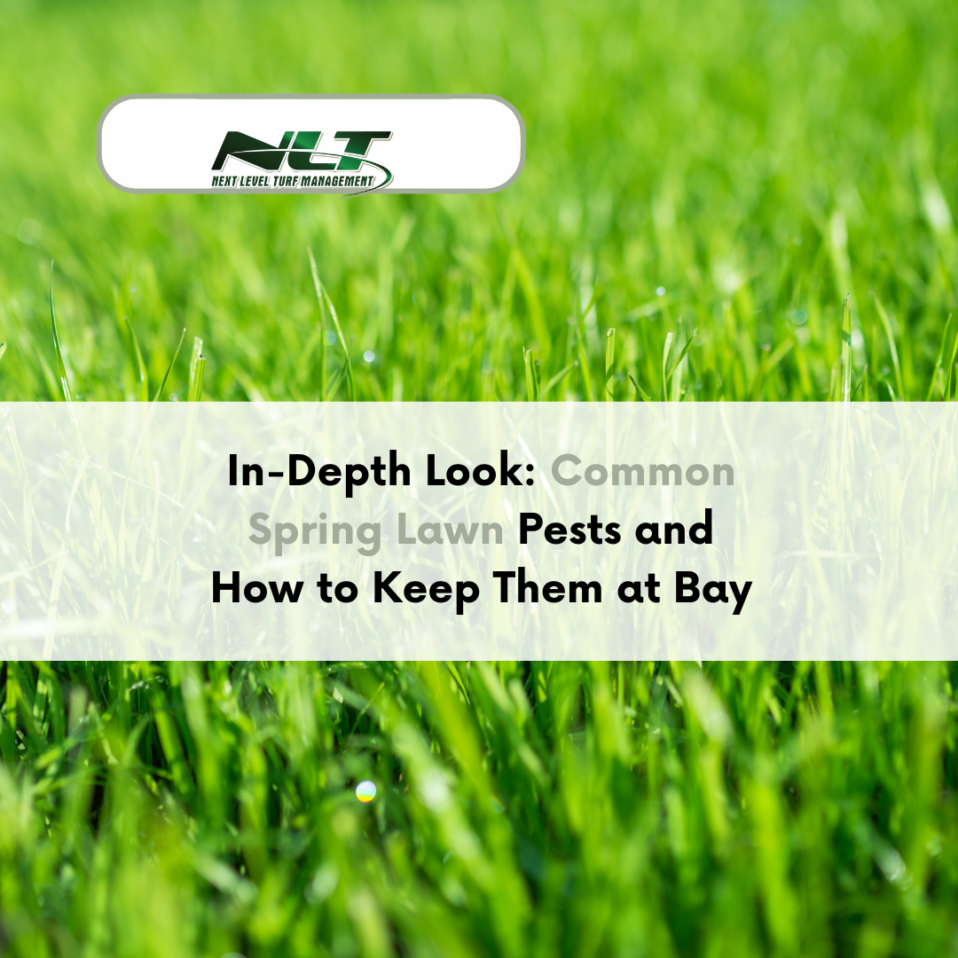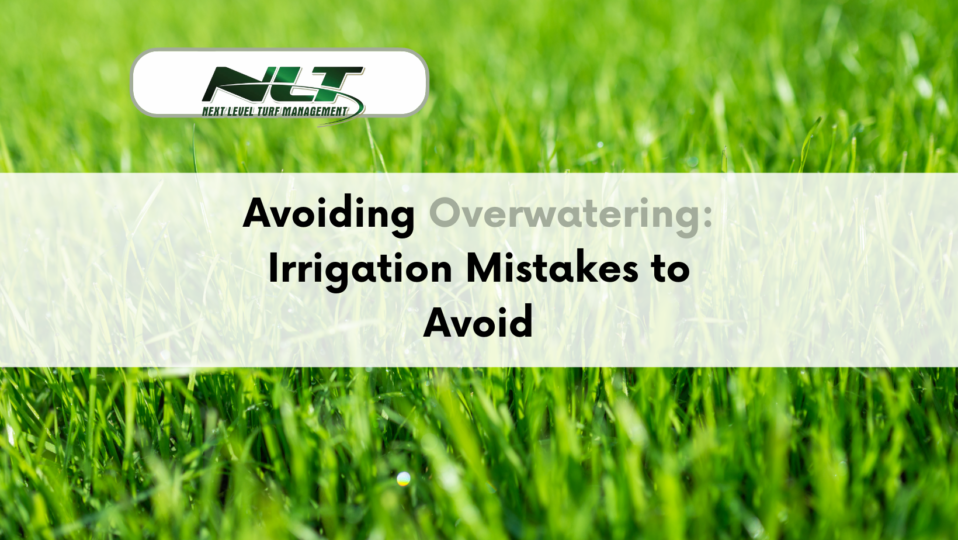Embrace a Pest-Free Spring Lawn with Central Florida’s Premier Turf Management Company
As the signs of winter fade and spring burst forth, homeowners in Central Florida eagerly anticipate the return of greenery and the revival of their yards. However, the onset of spring also ushers in a new battle against a familiar foe: lawn pests. From munching caterpillars to tunneling mole crickets, these creatures can wreak havoc on even the most well-maintained lawns. While some lawn pests are merely an eyesore, others pose significant threats to the health and integrity of your turf, potentially causing lasting damage if left unchecked. Thankfully, Central Florida’s premier turf management company, Next Level Turf, is here to help.
In this comprehensive guide, we’ll explore the most common spring lawn pests in Central Florida and provide valuable insights into effectively keeping these unwelcome invaders at bay. Equipped with this knowledge, you can protect your lush lawn from pest-induced damage, ensuring a harmonious and thriving outdoor space for your family to enjoy all season long.
Join us as we dive into the world of spring lawn pests and let Next Level Turf guide you through the process of protecting your lawn from these destructive intruders, paving the way for a healthier, more beautiful, and inviting landscape this season.
Identifying Common Spring Lawn Pests in Central Florida
Before diving into strategies for preventing lawn pests, it is crucial to understand the common culprits that plague Central Florida’s yards during the spring season. Each pest has its own unique characteristics, habits, and life cycle, so accurately identifying them enables targeted and effective control methods. Some of the most common lawn pests in the region include:
- Chinch Bugs: These small, black insects are notorious for the damage they inflict on St. Augustine grass, which is prevalent in Central Florida. Chinch bugs feed on the grass by extracting plant sap, causing yellowing and death of the turf. Their swift reproduction and ability to develop resistance to pesticides make them a formidable adversary for homeowners striving to maintain a healthy lawn.
- Mole Crickets: These burrowing insects tunnel through the soil, creating air pockets that weaken the grassroots while promoting weed growth. Underneath their crisp brown exterior, they have unique, mole-like front limbs specialized for digging. Mole crickets can uproot plants and seedlings by feeding on roots in large numbers, causing extensive lawn damage within a short period.
- Sod Webworms: Sod webworms, or lawn caterpillars, are the larval stage of small brown moths. They are notoriously voracious feeders, consuming grass blades while hiding during the day and emerging at night to forage. Infestations can lead to severe defoliation and unsightly patches on lawns, with Bermudagrass, St. Augustine, and Zoysiagrass among their favorite targets.
- Armyworms: Another caterpillar species, armyworms, feed on grass surfaces and tender foliage. These green or gray caterpillars move in large groups, consuming vast expanses of grass in a short time, hence their name. An unchecked armyworm infestation can leave a lawn looking as if it has been mowed too short, stunting growth and leaving it susceptible to further damage by other pests or diseases.
Proactive Inspection for Early Pest Detection
One of the most effective ways to prevent significant lawn damage from pests is to conduct regular inspections. Early detection allows you to address infestations promptly, preventing them from establishing and causing potential devastation. Implement the following inspection strategies to stay ahead of lawn pests:
- Establish a Routine: Consistency is key in lawn inspections. Set a routine to inspect your lawn weekly, focusing on areas near buildings, fences, and garden borders where pests like to hide. Check for off-colored patches, insects, and damaged grass blades, as well as other signs of pest activity.
- Monitor Moisture Levels: Many lawn pests thrive in damp environments, so closely monitoring soil moisture and adjusting your watering practices accordingly can serve as an effective preventive measure. Overwatering may encourage insect and disease infestations, while underwatering can weaken the grass and leave it vulnerable to pests. Aim for a balanced approach by watering deeply and infrequently to maintain your lawn’s health and vigor.
- Nighttime Inspection: Since many lawn pests are nocturnal, it is essential to conduct occasional nighttime inspections. Equip yourself with a flashlight and head out to your yard to look for pest activity, such as active caterpillars or mole crickets. Catching these critters in the act can help you quickly address infestations before they have a chance to intensify.
Cultivating a Strong and Pest-Resistant Lawn
A well-maintained, healthy lawn is innately more resistant to pest invasions. Adhering to best practices in lawn care promotes robust, hardy grass that withstands pest pressures and recovers more swiftly from minor damage. Focus on these key areas to cultivate a pest-resistant lawn:
- Mowing and Aeration: Proper mowing promotes dense, vigorous turf growth, which can deter pests from taking hold. Maintain a consistent mowing schedule, but avoid cutting your grass too short, as this can weaken the turf and enable pests to invade more easily. Additionally, regular aeration can counteract lawn compaction caused by mole cricket tunnels, reducing the risk of extensive turf damage.
- Fertilization: A well-fertilized lawn is more resilient and better equipped to outcompete weeds and withstand the stress of pest activity. It is essential to use the appropriate fertilizers for your grass type and follow recommended application rates and schedules. Over-fertilization can promote excessive growth, which may attract certain pests.
- Pest-Resistant Grass Varieties: When possible, opt for pest-resistant grass varieties suitable for Central Florida’s climate. For example, newer cultivars of St. Augustine grass, such as Floratam, have demonstrated greater resistance to chinch bug infestations. Integrating these varieties into your lawn can significantly reduce the likelihood of pests damaging your turf.
As a premier turf management company, our team provides expert support and solutions to help you cultivate a healthy, vibrant, and pest-resistant lawn. By combining our knowledge and expertise with your dedication to proactive and thoughtful lawn care, we can prevent spring pests from ever gaining a foothold in your yard.
Implementing Biological Control Methods
Biological control entails introducing beneficial organisms into your lawn to combat and suppress pest populations. By promoting natural predators’ presence, you can maintain a healthy balance and keep pests in check without relying solely on chemicals. Some effective biological control strategies include:
- Encouraging Predators: Foster a welcoming environment for natural predators, such as birds, frogs, and insects like ladybugs and lacewings, which help control pests like chinchbugs and caterpillars. Installing bird feeders, bird baths, and shelters, as well as maintaining diverse plant life in your landscape, can attract and support these beneficial creatures.
- Parasitic Nematodes: Introducing beneficial parasitic nematodes can help reduce mole cricket populations. These microscopic worms infiltrate and kill pests without damaging your lawn or posing a threat to non-target organisms. For optimum results, apply nematodes when mole cricket populations are in their early stages, typically during late summer or early fall.
- Bacillus thuringiensis (Bt): This soil-dwelling bacterium produces a toxic protein that specifically targets caterpillars such as sod webworms and armyworms. Bt is safe for humans, pets, and beneficial insects, serving as an eco-friendly and effective control method for caterpillar infestations. Bt-based products are typically available in liquid or granular form and should be applied according to label instructions for best results.
Spot Treatment and Judicious Use of Chemicals
While prevention and early detection are crucial in managing pest problems, sometimes targeted treatments are necessary to eliminate or control infestations. The key is to utilize chemicals responsibly and choose the least toxic options available. Some tips for responsible chemical use include:
- Selective Pesticide Application: Apply chemical treatments only when necessary and where pest populations are concentrated. Spot treatment is more efficient and eco-friendly compared to blanket applications, which can harm non-target organisms and disrupt the natural balance in your lawn.
- Choose Low-Impact Pesticides: When using chemicals, opt for lower-impact options such as organic or reduced-risk pesticides. These products target specific pest species, minimizing harm to beneficial insects, the environment, and human health. The Environmental Protection Agency (EPA) has a list of reduced-risk pesticides that can help guide your selection.
- Follow Label Instructions: Adhere to label instructions for proper application rates, timing, and safety precautions. Over-application or incorrect usage can lead to chemical runoff and environmental harm and may even exacerbate pest problems by encouraging pesticide resistance.
- Rotate Chemicals: Strategically rotate the types of pesticides used to avoid resistance development in pest populations. Aim for products with different modes of action that interrupt the pest’s life cycle, thereby reducing the chances of pests becoming immune to treatments.
Seeking Expert Guidance for Comprehensive Lawn Care
No two lawns are identical, and what works for one homeowner may not be suitable for another. Given the vast array of factors influencing lawn health and pest pressures, seeking expert guidance is a wise investment. Professional lawn care services can provide:
- Customized Pest Control Programs: Expert technicians can create targeted pest management plans tailored to your lawn’s specific needs and challenges. Using their wealth of knowledge and expertise, they can implement holistic strategies and integrated techniques to strike at the heart of your lawn’s pest problems.
- Advanced Diagnostics and Treatment Application: Skilled professionals have access to advanced diagnostic tools and treatments, enabling early intervention before pest populations spiral out of control. They are also trained in proper pesticide application, ensuring effective and responsible use that minimizes chemical exposure to you, your family, and the environment.
- Ongoing Support and Monitoring: Partnering with a professional lawn care provider ensures ongoing assistance, including regular monitoring, treatment adjustments as needed, and progress tracking. This comprehensive approach helps maintain a healthy, pest-free lawn over time rather than simply resolving temporary infestations.
- Lawn Recovery and Restoration: Expert technicians can offer invaluable support in the event of severe lawn damage caused by pest infestations. Through tailored recovery and restoration programs, they can help your turf bounce back, providing insights and recommendations on preventing similar issues in the future.
Understanding the Importance of Soil Health
The foundation of any thriving lawn is healthy, nutrient-rich soil. Maintaining optimal soil health not only supports vigorous grass growth but also plays a significant role in preventing and managing pest infestations. The following tips can help boost your soil’s health and improve its ability to suppress pests naturally:
- Regular Soil Testing: Periodic soil testing allows you to identify nutrient deficiencies, imbalances, and other issues that may compromise your turf’s health and invite pests. By addressing these problems, you can create a more fertile, supportive environment for grass growth while discouraging the establishment of unwanted insects and weeds.
- Promote Soil Microbes: A diverse and robust microbial community in your soil can enhance its fertility while simultaneously hindering the spread of harmful pests. Encourage the growth of beneficial soil microbes by incorporating organic matter and employing no-till or low-tillage practices, which prevent the disruption of delicate microbial networks.
- Maintain Proper pH Levels: An improper soil pH can result in a nutrient lockout, inhibiting grass growth and making your lawn more vulnerable to pests. Most turfgrass species thrive in slightly acidic soil with a pH between 6.0 and 7.0. Performing routine soil tests and adjusting pH as needed will help keep your lawn in peak condition.
- Enhance Soil Structure and Drainage: Compacted soil with poor drainage not only impedes root growth but can also create a conducive environment for certain pests. Counteract this by aerating and amending your soil with organic matter such as compost, which can dramatically improve soil structure and drainage while promoting biodiversity.
Combating Common Lawn Diseases that Attract Pests
Lawn diseases can create an ideal environment for pests by weakening turf and turning your yard into a breeding ground for insects. By proactively addressing these diseases, you can minimize the risk of subsequent pest infestations. Here are some strategies for recognizing and managing lawn diseases:
- Early Detection: Much like pests, early detection of lawn diseases is crucial in preventing their spread and minimizing damage. Regularly inspect your yard for irregular patchiness, discoloration, or thinning, and address any issues promptly. Engaging a professional lawn care service can be helpful, as they are trained to recognize and treat various lawn diseases.
- Implement Proper Lawn Care Practices: Many lawn diseases result from poor care practices, such as overwatering, mowing too low, or inadequate fertilization. By adhering to recommended lawn care guidelines, you can prevent diseases from taking hold and discourage pests from invading.
- Choose Disease-Resistant Grass Varieties: If your lawn is particularly susceptible to specific diseases, consider planting disease-resistant grass cultivars. These varieties have been developed to withstand particular diseases better, subsequently reducing the risk of pest infestations that may follow an outbreak.
Educating Yourself on Lawn Pest and Disease Interactions
Understanding the intricate relationships between lawn pests and diseases can help you develop a more comprehensive and effective pest management strategy. Some pests are known to spread or thrive in the presence of diseases, and vice versa. Here are some examples of interactions between pests and diseases that homeowners should be aware of:
- Fungal Infections and Pest Infestations: Some pests, such as chinch bugs, exacerbate the impact of fungal diseases like gray leaf spots. Feeding damage caused by these pests can create entry points for fungal pathogens, resulting in compounded harm to your lawn.
- Pest Predisposition to Certain Grass Diseases: Lawn pests can be more attracted to turfgrass experiencing specific diseases or stressors. For example, armyworms are known to be more prevalent in lawns suffering from drought stress. By addressing the underlying issues that may attract pests, you can mitigate the risk of infestations.
- Disease Suppression by Natural Predators: Beneficial insects and other natural predators can play an essential role in suppressing pests and diseases. Encouraging these beneficial organisms in your landscape can provide a valuable line of defense against a wide array of threats to your lawn.
Achieving Long-Lasting, Pest-Free Lawn Success
Combating lawn pests is a multi-faceted challenge that requires dedication, preparation, and finesse. By incorporating preventative measures, promoting beneficial organisms, and addressing their root causes, you can confidently tackle and manage existing and potential pest infestations. Although vigilance is necessary, it need not be a solo endeavor. Partnering with a professional lawn care service like Next Level Turf Management can provide you with invaluable resources, industry expertise, and ongoing support in your quest to cultivate a beautiful, healthy, pest-free lawn. The culmination of these efforts will result in a lush, thriving outdoor space that enhances your property’s curb appeal and serves as a source of pride and enjoyment for your family. Embrace a comprehensive and sustainable approach to lawn pest management today and discover the innumerable benefits of resilient, vibrant turf. Contact us now to start your journey toward the perfect lawn and a pest-free oasis.







Post a comment